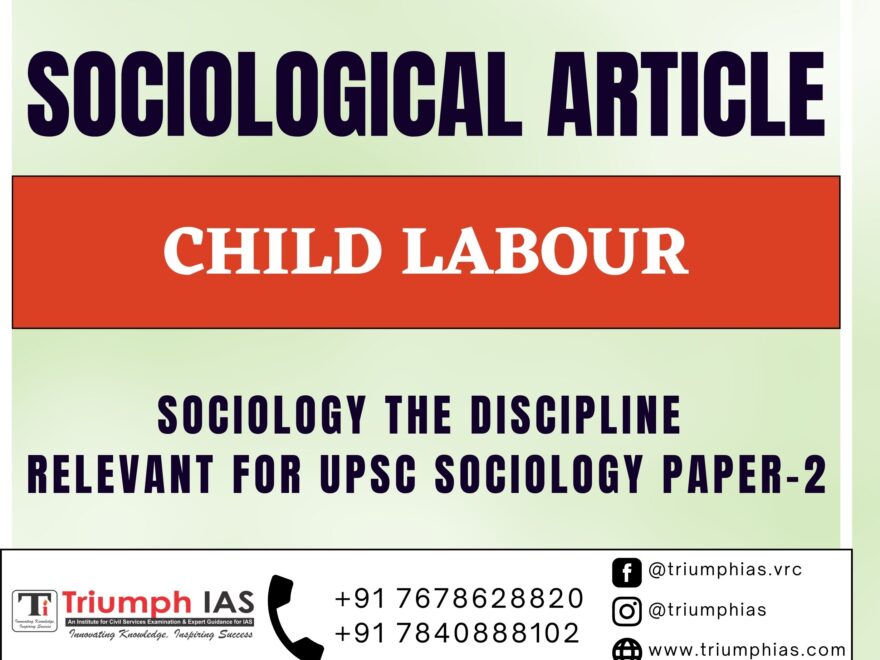Child Labour – Sociology Paper 2
The Kerala High Court recently ruled that two children from Delhi, who were believed to have been forced into child labour by selling items on the streets, should be released from a shelter home and placed in the care of their parents.
First Know about the Problem of “Child Labour in India“.
Child labour is a widespread and complex issue in India. While it is illegal for children under the age of 14 to work in India, millions of children are still engaged in labour. Many of these children are forced to work in hazardous and exploitative conditions, including in the illegal production of goods such as fireworks, matchsticks, and tobacco. Others work in the informal sector, including as domestic servants and in small-scale industries such as brick kilns and garment factories.
There are many factors that contribute to the high rates of child labour in India. Poverty is a major factor, as many families rely on the income that children bring in to survive. Lack of access to education is another factor, as many children are unable to attend school due to financial constraints or because they are needed to work to support their families. The widespread availability of cheap labour also makes it attractive for businesses to employ children, who are often paid less and are less likely to complain about poor working conditions.
Efforts to combat child labour in India have been ongoing for many years, with mixed results. The government has implemented several programs and policies to address the issue, including the National Child Labour Project, which provides financial incentives for families to send their children to school instead of work. However, enforcement of these policies has been weak, and there is still a long way to go to eliminate child labour in India.
In conclusion, child labour remains a significant problem in India, with millions of children being forced to work in hazardous and exploitative conditions. While there have been some efforts to address the issue, more needs to be done to ensure that all children in India are able to enjoy their right to an education and a childhood free from work.
Marine Drive Child Labour Case
In November 2022, the police took two children on suspicion of being forced into child labour by selling items on the streets. The children were taken to a Child Welfare Committee and placed in a shelter home.
According to the Chairperson of the Child Welfare Committee, the police found the two children selling pens and other items in the Marine Drive area of Delhi. This activity was considered child labour, so the children were taken to the Child Welfare Committee. The Committee determined that the children fell under the category of “children in need of care and protection” as defined in the Juvenile Justice Act of 2015 and ordered that they be placed in the care of a shelter home. The Committee argued that it would be best for the children’s holistic development and cultural growth if they were sent to the Child Welfare Committee in Delhi for rehabilitation.
The court, after considering the arguments presented by the petitioners and the government, ruled that the police or Child Welfare Committee cannot take children into custody and separate them from their parents. The petitioners also promised not to allow the children to sell items on the streets and to ensure that they receive an education. The court stated that the best way for the children to have a holistic development is to remain with their biological family and for the state to provide them with proper education, opportunities, and resources for healthy development in a free and dignified environment. As a result, the court ordered that the children be released to the custody of their parents.
Follow us :
🔎 https://www.instagram.com/triumphias
🔎https://www.youtube.com/c/TriumphIAS
https://t.me/VikashRanjanSociology
Find More Blogs
|
Scope of the subject and comparison with other social sciences |
|||
|
|
|
|
Modernity and social changes in Europe |
#childlabourinindiaessay #causesofchildlabourinindia #effectsofchildlabourinindia #childlabourinindiaarticle #childlabourinindiaanalysis #childlabourinindiaasasocialissue #childlabourinindiaanoverview #aboutchildlabourinindia #articleonchildlabourinindia #ageofchildlabourinindia #advantagesofchildlabourinindia #analysisofchildlabourinindia #agelimitforchildlabourinindia #atruestoryonchildlabourinindia #childlabourinbritishindia #childlabourbannedinindia #childlabourinbrickkilnsinindia #childlabourstillabigchallengeinindia
child labour in india essay, causes of child labour in india, effects of child labour in india, child labour in india article, child labour in india analysis, child labour in india as a social issue, child labour in india an overview, about child labour in india, article on child labour in india, age of child labour in india, advantages of child labour in india, analysis of child labour in india, age limit for child labour in india, a true story on child labour in india, child labour in british india, child labour banned in india, child labour in brick kilns in india, child labour still a big challenge in india

